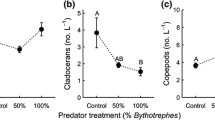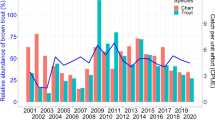Abstract
Patterns of animal migration and the ecological forces that shape them have been studied for centuries. Yet ecological impacts caused by the migration, such as altered predator–prey interactions and effects on community structure, remain poorly understood. This is to a large extent due to the scarcity of naturally replicated migration systems with negative controls, that is, ecosystems without migration. In this study, we tested whether partial migration of certain species within the overall prey community affects foraging ecology of top predators and thereby alters energy pathways in food webs. We carried out the study in independent replicated freshwater lake systems, four with and four without opportunity for prey migration. Specifically, we compared predator foraging mode in lakes where cyprinid prey fish perform seasonal partial migrations into connected streams with lakes lacking migratory opportunities for prey fish. We found clear seasonal bottom-up effects of prey migration on predators, including changes in size structure and total biomass of ingested prey, size-specific changes in littoral versus pelagic origin of diet, and a higher degree of feast-and-famine for predators in systems with migratory prey. Our analyses further showed that partially migratory prey species constitute a larger part of the prey community in systems that allow migration. Hence, prey migrations have important implications for predator foraging ecology and may cause seasonal shifts in the importance of their supporting energy pathways. We suggest that such bottom-up effects of partial migration may be a widespread phenomenon both in aquatic and in terrestrial ecosystems.






Similar content being viewed by others
References
Alerstam T, Hedenström A, Åkesson S. 2003. Long-distance migration: Evolution and determinants. Oikos 103:247–60.
Altizer S, Bartel R, Han BA. 2011. Animal migration and infectious disease risk. Science 331:296–302.
Armstrong JB, Schindler DE. 2011. Excess digestive capacity in predators reflects a life of feast and famine. Nature 476:84–7.
Bauer S, Hoye BJ. 2014. Migratory animals couple biodiversity and ecosystem functioning worldwide. Science 344:1242552.
Bowler DE, Benton TG. 2005. Causes and consequences of animal dispersal strategies: relating individual behaviour to spatial dynamics. Biological Reviews 80:205–25.
Brodersen J, Ådahl E, Brönmark C, Hansson L-A. 2008a. Ecosystem effects of partial fish migration in lakes. Oikos 117:40–6.
Brodersen J, Nilsson PA, Hansson L-A, Skov C, Brönmark C. 2008b. Condition-dependent individual decision-making determines cyprinid partial migration. Ecology 89:1195–200.
Brodersen J, Nicolle AP, Nilsson PA, Skov C, Brönmark C, Hansson L-A. 2011a. Interplay between temperature, fish partial migration and trophic dynamics. Oikos 120:1838–46.
Brodersen J, Rodriguez-Gil JL, Jönsson M, Hansson L-A, Brönmark C, Nilsson PA, Berglund O. 2011b. Temperature and resource availability may interactively affect over-wintering success of juvenile fish in a changing climate. PloS ONE 6:e24022.
Brodersen J, Chapman BB, Nilsson PA, Skov C, Hansson LA, Brönmark C. 2014. Fixed and flexible: coexistence of obligate and facultative migratory strategies in a freshwater fish. PloS ONE 9:e90294.
Brodersen J, Howeth JG, Post DM. 2015. Emergence of a novel prey life history promotes contemporary sympatric diversification in a top predator. Nature Communications 6:8115.
Brönmark C, Skov C, Brodersen J, Nilsson PA, Hansson L-A. 2008. Seasonal migration determined by a trade-off between predator avoidance and growth. PLoS ONE 3:e1957.
Brönmark C, Hulthén K, Nilsson PA, Skov C, Hansson L-A, Brodersen J, Chapman BB. 2014. There and back again: migration in freshwater fishes. Canadian Journal of Zoology 91:1–13.
Chapman BB, Hulthén K, Blomqvist DR, Hansson LA, Nilsson JÅ, Brodersen J, Brönmark C. 2011. To boldly go: individual differences in boldness influence migratory tendency. Ecology Letters 14:871–6.
Chapman BB, Skov C, Hulthén K, Brodersen J, Nilsson PA, Hansson L-A, Brönmark C. 2012. Partial migration in fishes: definitions, methodologies and taxonomic distribution. Journal of Fish Biology 81:479–99.
Chapman BB, Hulthén K, Brönmark C, Nilsson PA, Skov C, Hansson L-A, Brodersen J. 2015. Shape up or ship out: migratory behaviour predicts morphology across spatial scale in freshwater fish. Journal of Animal Ecology 84:1187–93.
Dingle H, Drake VA. 2007. What is migration? Bioscience 57:113–21.
Elbroch LM, Lendrum PE, Newby J, Quigley H, Craighead D. 2013. Seasonal foraging ecology of non-migratory cougars in a system with migrating prey. PLoS One 8:83375.
Faulks L, Svanbäck R, Eklöv P, Östman Ö. 2015. Genetic and morphological divergence along the littoral–pelagic axis in two common and sympatric fishes: perch, Perca fluviatilis (Percidae) and roach, Rutilus rutilus (Cyprinidae). Biological Journal of the Linnean Society 114:929–40.
Fryxell JM, Sinclair ARE. 1988. Causes and consequences of migration by large herbivores. Trends in Ecology & Evolution 3:237–41.
Fryxell JM, Mosser A, Sinclair ARE, Packer C. 2007. Group formation stabilizes predator–prey dynamics. Nature 449:1041–3.
Furey NB, Hinch SG, Mesa MG, Beauchamp DA. 2016. Piscivorous fish exhibit temperature-influenced binge feeding during an annual prey pulse. Journal of Animal Ecology 85:1307–17.
Gelin ML, Branch LC, Thornton DH, Novaro AJ, Gould MJ, Caragiulo A. 2017. Response of pumas (Puma concolor) to migration of their primary prey in Patagonia. PLoS ONE 12:e0188877.
Hansson L-A, Åkesson S. 2014. Animal movement across scales. Oxford: Oxford University Press.
Hays GC. 2003. A review of the adaptive significance and ecosystem consequences of zooplankton diel vertical migrations. Hydrobiologia 503:163–70.
Hilderbrand GV, Farley SD, Robbins CT, Hanley TA, Titus K, Servheen C. 1996. Use of stable isotopes to determine diets of living and extinct bears. Canadian Journal of Zoology 74:2080–8.
Hjelm J, van de Weerd GH, Sibbing FA. 2003. Functional link between foraging performance, functional morphology, and diet shift in roach (Rutilus rutilus). Canadian Journal of Fisheries and Aquatic Sciences 60:700–9.
Holtgrieve GW, Schindler DE. 2011. Marine-derived nutrients, bioturbation, and ecosystem metabolism: reconsidering the role of salmon in streams. Ecology 92:373–85.
Hulthén K, Chapman BB, Nilsson PA, Vinterstare J, Hansson LA, Skov C, Brönmark C. 2015. Escaping peril: perceived predation risk affects migratory propensity. Biology Letters 11:20150466.
Jepsen N, Berg S. 2002. The use of winter refuges by roach tagged with miniature radio transmitters. Hydrobiologia 483:167–73.
Light RW, Adler PH, Arnold DE. 1983. Evaluation of gastric lavage for stomach analyses. North American Journal of Fisheries Management 3:81–5.
Metz MC, Smith DW, Vucetich JA, Stahler DR, Peterson RO. 2012. Seasonal patterns of predation for gray wolves in the multi-prey system of Yellowstone National Park. Journal of Animal Ecology 81:553–63.
Nilsson PA, Brönmark C. 2000. Prey vulnerability to a gape-size limited predator: behavioural and morphological impacts on northern pike piscivory. Oikos 88:539–46.
Owen-Smith N. 2008. Changing vulnerability to predation related to season and sex in an African ungulate assemblage. Oikos 117:602–10.
Post DM. 2002. Using stable isotopes to estimate trophic position: models, methods, and assumptions. Ecology 83:703–18.
Post DM, Palkovacs EP, Schielke EG, Dodson SI. 2008. Intraspecific phenotypic variation in a predator affects zooplankton community structure and cascading trophic interactions. Ecology 89:2019–32.
R Development Core Team. (2016). R: a language and environment for statistical computing. R Foundation for Statistical Computing, Vienna.
Samelius G, Alisauskas RT, Larivière S. 2011. Seasonal pulses of migratory prey and annual variation in small mammal abundance affect abundance and reproduction by arctic foxes. Polar biology 34:1475–84.
Sand H, Wabakken P, Zimmermann B, Johansson O, Pedersen HC, Liberg O. 2008. Summer kill rates and predation pattern in wolf—moose system: can we rely on winter estimates? Oecologia 156:53–64.
Schielke EG, Post DM. 2010. Size matters: comparing stable isotope ratios of tissue plugs and whole organisms. Limnology and Oceanography: Methods 8:348–51.
Schindler DE, Scheuerell MD, Moore JW, Gende SM, Francis TB, Palen WJ. 2003. Pacific salmon and the ecology of coastal ecosystems. Frontiers in Ecology and the Environment 1:31–7.
Sinclair ARE. 2003. Mammal population regulation, keystone processes and ecosystem dynamics. Philosophical Transactions of the Royal Society of London B: Biological Sciences 358:1729–40.
Skov C, Lousdal O, Johansen PH, Berg S. 2003. Piscivory of 0+ pike (Esox lucius L.) in a small eutrophic lake and its implications for biomanipulation. Hydrobiologia 506:481–7.
Skov C, Brodersen J, Nilsson PA, Hansson L-A, Brönmark C. 2008. Inter- and size-specific patterns of fish seasonal migration between a shallow lake and its streams. Ecology of Freshwater Fish 17:406–15.
Skov C, Aarestrup K, Baktoft H, Brodersen J, Brönmark C, Hansson LA, Nilsson PA. 2010. Influences of environmental cues, migration history, and habitat familiarity on partial migration. Behavioral Ecology 21:1140–6.
Skov C, Baktoft H, Brodersen J, Brönmark C, Chapman BB, Hansson L-A, Nilsson PA. 2011. Sizing up our enemy: individual predation vulnerability predicts migratory probability. Proceedings of the royal society b 278:1414–18.
Skov C, Jepsen N, Baktoft H, Jansen T, Pedersen S, Koed A. 2014. Cormorant predation on PIT-tagged lake fish. Journal of Limnology 73:177–86.
Subalusky AL, Dutton CL, Rosi-Marshall EJ, Post DM. 2017. Annual mass drownings of the Serengeti wildebeest migration influence nutrient cycling and storage in the Mara River. Proceedings of the National Academy of Sciences 114:7647–52.
Temple GK, Johnston IA. 1997. The thermal dependence of fast-start performance in fish. Journal of Thermal Biology 22:391–401.
Thompson JM, Bergersen EP, Carlson CA, Kaeding LR. 1991. Role of size, condition, and lipid content in the overwinter survival of age− 0 Colorado Squawfish. Transactions of the American Fisheries Society 120:346–53.
Vander Zanden MJ, Vadeboncoeur Y. 2002. Fishes as integrators of benthic and pelagic food webs in lakes. Ecology 83:2152–61.
Acknowledgements
The authors acknowledge the technicians at DTU AQUA for their invaluable expertise during sampling. We thank Serge Robert and Carsten Schubert at Eawag Department of Surface Waters Research and Management for isotope analyses support. The study received financial support from the Danish National Fishing Licence Funds and was carried out according to the guidelines of Danish and Swedish ethical requirements and animal welfare legislation. JB was funded by a Swedish Research Council (VR) repatriation grant.
Author information
Authors and Affiliations
Corresponding author
Additional information
Author’s Contribution
JB conceived the ideas and designed the study with support from CS, CB, KH, LAH, BBC and PAN; JB and CS collected the data; JHH analysed the samples; JB and HB analysed the data (HB specifically CPUE and length–weight relationship); JB and JHH led the writing of the manuscript. All authors read and commented upon earlier versions of the manuscript and gave final approval for publication.
Electronic supplementary material
Below is the link to the electronic supplementary material.
Rights and permissions
About this article
Cite this article
Hansen, J.H., Skov, C., Baktoft, H. et al. Ecological Consequences of Animal Migration: Prey Partial Migration Affects Predator Ecology and Prey Communities. Ecosystems 23, 292–306 (2020). https://doi.org/10.1007/s10021-019-00402-9
Received:
Accepted:
Published:
Issue Date:
DOI: https://doi.org/10.1007/s10021-019-00402-9




